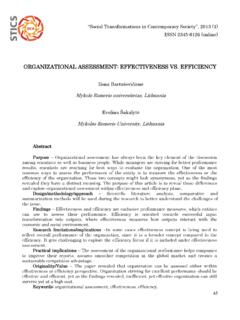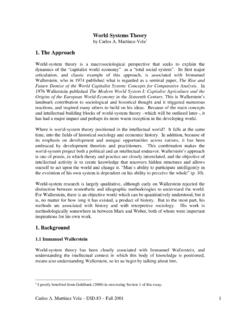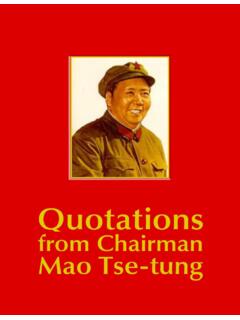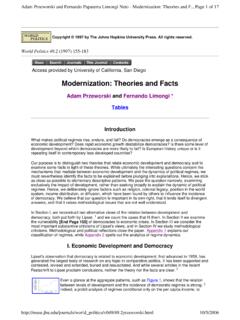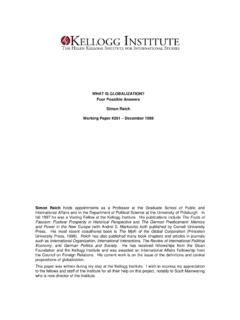Transcription of MODELING A VALUE CHAIN IN PUBLIC SECTOR
1 Social Transformations in Contemporary Society'', 2014 (2). ISSN 2345-0126 (online). MODELING A VALUE CHAIN IN PUBLIC SECTOR . Daiva Rapcevi ien . Mykolas Romeris University, Lithuania Abstract Purpose Over the past three decades comprehensive insights were made in order to design and manage the VALUE CHAIN . A lot of scholars discuss differences between private SECTOR VALUE CHAIN creation profit for the business and PUBLIC SECTOR VALUE CHAIN , the approach that PUBLIC SECTOR creates VALUE through the services that it provides. However, there is a lack of a common understanding of what PUBLIC SECTOR VALUE CHAIN is in general. This paper reviews the literature on how the private VALUE CHAIN was transformed into PUBLIC VALUE CHAIN and reviews a determination and architecture of a VALUE CHAIN in PUBLIC SECTOR which gives a structural approach to greater picture of how all structure works.
2 It reviews an approach that the VALUE CHAIN for the PUBLIC SECTOR shows how the PUBLIC SECTOR organizes itself to ensure it is of VALUE to the citizens. Design/methodology/approach descriptive method, analysis of scientific literature. Findings The PUBLIC SECTOR VALUE CHAIN is an adaptation of the private SECTOR VALUE CHAIN . The difference between the two is that the customer is the focus of the PUBLIC SECTOR context, versus the profit focus in the private SECTOR context. There are significant similarities between the two CHAIN models. Each of the CHAIN models are founded on a series of core components. For the PUBLIC SECTOR context, the core components are people, service and trust. Research limitations/implications this paper based on presenting VALUE CHAIN for both private and PUBLIC sectors and giving deeper knowledge for PUBLIC SECTOR VALUE CHAIN model.
3 Practical implications comprehension of general VALUE CHAIN model concept and PUBLIC SECTOR VALUE CHAIN model helps to see multiple connections throughout the entire process: from the beginning to the end. The paper presents the theoretical framework for further study of the VALUE CHAIN model for waste management creation. Originality/ VALUE The paper reveals the systematic conceptual overview on comprehension of VALUE CHAIN model for both private and PUBLIC sectors. Keywords: VALUE CHAIN , PUBLIC SECTOR , VALUE model. Research type: scientific literature review. Introduction VALUE CHAIN Management is a broad topic and has been examined and expanded by researchers from different angles over the last thirty years. One prominent research eld 42. Social Transformations in Contemporary Society'', 2014 (2).
4 ISSN 2345-0126 (online). is sustainability in VALUE CHAIN management. PUBLIC services can be regarded as a critical factor for the competitive development and the growth of country systems' (national economic, social and industrial systems). According to this approach, the organizations or any PUBLIC body, or even concession operator operating in the PUBLIC SECTOR play a key role as providers of services of general interest, which unquestionably have a strong impact on both the life quality of citizens and the productivity of enterprises. The performances of these organizations should be characterized by high quality and cost effectiveness as the aim is to bring PUBLIC Administration as much closer as possible to citizens and enterprises by creating ' PUBLIC VALUE ' through the production of services increasingly more tailored to the needs of users.
5 Evolution of VALUE CHAIN concept The VALUE CHAIN itself describes the full range of activities which are required to bring a product or service from conception, through the different phases of production (involving a combination of physical transformation and the input of various producer services), delivery to final consumers, and final disposal after use (Kaplinsky and Morris, 2000). The concept of VALUE CHAIN came from business management and was first described and mostly popularized by Michael Porter in his 1985 best-seller Competitive Advantage: Creating and Sustaining Superior Performance . Porter termed the larger interconnected system of VALUE chains the " VALUE system". All firms' activities were divided into two VALUE streams: primary and supportive activities. Primary activities relate directly to the physical creation, sale, maintenance and support of a product or service, while support activities support the primary functions.
6 This VALUE system includes the VALUE chains of a firm's supplier (and their suppliers all the way back), the firm itself, the firm distribution channels, and the firm's buyers. Source: Porter, 1998. Figure 1. Porter's VALUE CHAIN 43. Social Transformations in Contemporary Society'', 2014 (2). ISSN 2345-0126 (online). Porter's main idea of VALUE CHAIN is that VALUE CHAIN is a high-level model of how businesses receive raw materials as input, add VALUE through various processes, and sell finished products to customers. The VALUE CHAIN categorizes the generic VALUE -adding activities of an organization (Brown, 2009). All basic VALUE streams were introduced in Michael Porter's book but were explained more clearly by James Martin in his 1995 book called The Great Transition , where were pulled together many issues, models, and methods for transforming the traditional old- world organization into a VALUE -creating enterprise.
7 Martin uses VALUE stream, rather than process, to define the end-to-end stream of activities that deliver particular results for a given customer (external or internal). Ralph Whittle and Conrad Myrick in the book, Enterprise Business Architecture (2004), provides a common reference model by defining the business strategy, governance, organization, and business functions, and establishes a baseline that links strategy and results by defining which organizations perform those functions. This book provides a consistent classification of all the tasks, activities, functions, and processes into VALUE streams. A VALUE CHAIN is the disaggregating of a firm into its strategically relevant activities for the purpose of understanding the behavior of costs as well as the existing and potential sources of differentiation.
8 The concept has been extended beyond individual organizations. The industry wide synchronized interactions of those local VALUE chains create an extended VALUE CHAIN , sometimes global in extent. Capturing the VALUE generated along the CHAIN is the new approach taken by many management strategists. By exploiting the upstream and downstream information flowing along the VALUE CHAIN , the firms may try to bypass the intermediaries creating new business models (Brown, 2009). The promotion of VALUE chains is a complex challenge within the realm of private SECTOR development and beyond. Actors in a VALUE CHAIN may range from microenterprises to multinational corporations, and it is thus beyond doubt that developing a holistic approach to deal with such diverse actors is challenging (Stamm and Drachenfels, 2011).
9 Moreover, these actors the different links of the VALUE CHAIN can be embedded in quite different environments. Domestic VALUE chains may link rural producers with urban marketers; in global VALUE chains producers from developing countries might for example be linked to firms in industrialized countries. The specific location of firms implies differing regulatory frameworks and differing access to input factors and information. PUBLIC VALUE CHAIN Any PUBLIC SECTOR organization that provides services to the citizens plays a key role in VALUE creation for the country. Providing a quality service and creating PUBLIC goods, competitive development and the growth of the county are ensured. So the main issue for the PUBLIC SECTOR organizations is to create better VALUE through PUBLIC services and to meet needs provided by citizens, private organizations and other PUBLIC bodies.
10 44. Social Transformations in Contemporary Society'', 2014 (2). ISSN 2345-0126 (online). In the last three to four decades, government and business have been part of a far- reaching economic transformation, made possible by remarkable advances in information, communication and transport technologies. Both theory and practice in the private SECTOR have already identified a link between employee satisfaction and customer satisfaction, on the one hand, and between customer satisfaction and the bottom line, on the other. The combination of these two relationships yields a causal CHAIN in which an improvement in employee attitudes and behaviours leads to an improvement in customer attitudes and behaviours, which leads in turn to an increase in growth and profit. The main idea of the PUBLIC VALUE CHAIN architecture is creation of the two basic VALUE flows: 1.
